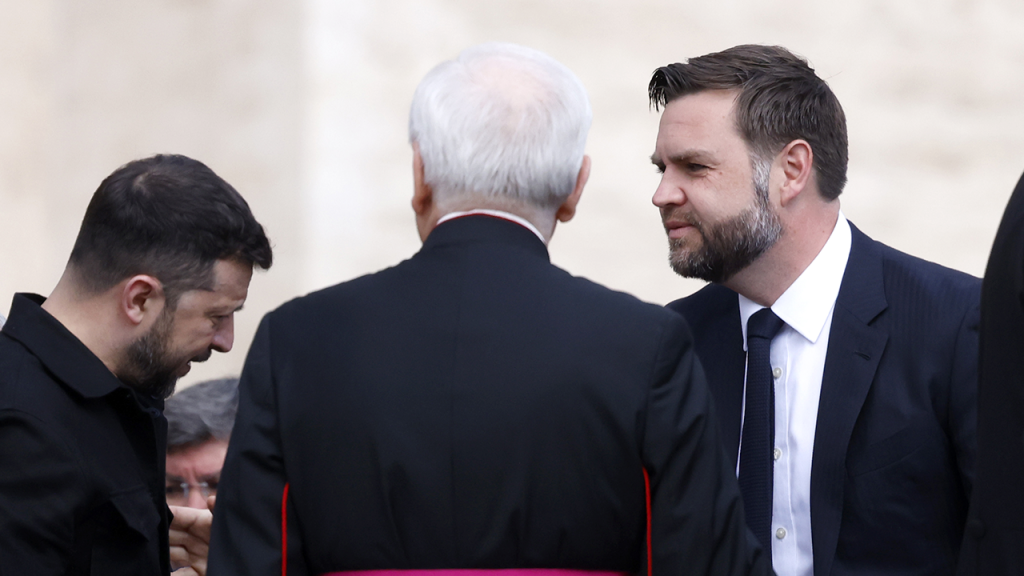In a significant diplomatic meeting held in Rome, U.S. Vice President JD Vance and Secretary of State Marco Rubio engaged with Ukrainian President Volodymyr Zelenskyy for in-depth discussions centered on the ongoing conflict between Russia and Ukraine. The forum, aimed at advancing peace negotiations, comes amidst ongoing hostilities, including a recent drone strike by Russia. This series of talks coincides with Pope Leo XIV’s inaugural mass at the Vatican, where world leaders gathered, highlighting the political urgency surrounding the war now in its third year.
| Article Subheadings |
|---|
| 1) Overview of the Meeting |
| 2) Relevance of the Vatican Setting |
| 3) Key Outcomes from the Discussions |
| 4) Ongoing Russian Threats |
| 5) Future Peace Initiatives |
Overview of the Meeting
The pivotal meeting in Rome featured representatives from the U.S. and Ukraine discussing strategies to pursue peace as the war between Russia and Ukraine continues to escalate. Vice President JD Vance and Secretary of State Marco Rubio, accompanying President Volodymyr Zelenskyy, delved into various issues surrounding the war, aiming to strengthen diplomatic relations and enhance support for Ukraine. This gathering underscores international concern over the ongoing conflict and reflects efforts by U.S. officials to facilitate more robust diplomatic engagement with Ukrainian leaders.
Relevance of the Vatican Setting
The selection of the Vatican as the meeting ground added symbolic weight, especially as world leaders gathered for Pope Leo XIV’s inaugural mass. This spiritual and diplomatic confluence highlighted not only a historical moment for the Catholic Church but also emphasized the urgency of resolving the conflict. The Vatican has historically played a role in mediating international disputes, and its involvement in this dialogue could indicate a new phase of humanitarian and diplomatic efforts aimed at ending the hostilities. Both political leaders and spiritual figures took this opportunity to address the crises ravaging Ukraine.
Key Outcomes from the Discussions
During the talks, President Zelenskyy reiterated Ukraine’s commitment to pursuing genuine diplomacy. He voiced that the presence of Russian representatives at the Istanbul talks had been insufficient for meaningful dialogue, highlighting the need for a full and unconditional ceasefire. The negotiations also touched upon sanctions against Russia, reinforcing the need for concerted pressure on Moscow to abandon aggression. Alongside discussions of economic collaboration, Zelenskyy affirmed that a notable prisoner exchange had been agreed upon, even though no ceasefire was reached. Thus, the meeting promoted the advancement of a framework for future negotiations.
Ongoing Russian Threats
Just hours after the Rome meetings, Russian aggression proved persistent. A drone strike carried out by Russian forces targeted a passenger bus in northeastern Ukraine, signaling that the conflict remains far from resolution. This immediate act of violence followed a diplomatic encounter, indicating the volatility and precariousness of the situation on the ground. The continuation of military operations amidst peace talks raises significant questions about the effectiveness of ongoing diplomatic efforts and the sincerity of Russia’s engagement in negotiations.
Future Peace Initiatives
Looking forward, the discussions in Rome represent just one step in a broader strategy aimed at culminating in effective peace talks. Both President Zelenskyy and U.S. officials have expressed hope that ongoing pressures on Russia will lead to a willingness on Moscow’s part to reconsider its aggressive stance. Former President Donald Trump expressed keen interest in facilitating a direct conversation with Russian President Vladimir Putin, intimating that future calls could pave the way for potential breakthroughs in negotiations. This dual approach of engaging diplomatically while maintaining pressure indicates the U.S. commitment to playing a leading role in brokering peace in this critical region.
| No. | Key Points |
|---|---|
| 1 | The U.S. and Ukraine held crucial talks in Rome focused on the ongoing conflict with Russia. |
| 2 | The Vatican served as a significant backdrop, emphasizing the conflict’s international ramifications. |
| 3 | Despite ongoing military aggression, a prisoner swap agreement was achieved. |
| 4 | Recent violence underscores the regional volatility and challenges peace negotiations face. |
| 5 | Future diplomatic initiatives involve continued pressure on Russia and engagement with key leaders. |
Summary
The diplomatic engagement in Rome spotlighted the urgent need for substantial progress towards peace in the ongoing Russia-Ukraine conflict. The talks, which featured a high-profile U.S. delegation, emphasized a commitment to real diplomacy and the importance of unity among allies. As the situation remains volatile, ongoing efforts to broker peace will likely continue as world leaders work to halt further bloodshed and establish a framework for stability in the region.
Frequently Asked Questions
Question: What were the main topics discussed in the Rome meeting?
The discussions addressed sanctions against Russia, bilateral trade, ongoing military situations, and the potential for a prisoner swap, despite the lack of a ceasefire agreement.
Question: Why is the Vatican significant in international diplomacy?
The Vatican often plays a mediating role in global conflicts, providing a neutral backdrop for discussions between warring parties and emphasizing humanitarian concerns.
Question: What actions have Russia and Ukraine taken since the peace talks?
Despite talks, recent violence, including Russian drone strikes, indicates continuing hostilities, while a significant prisoner swap has also occurred.
